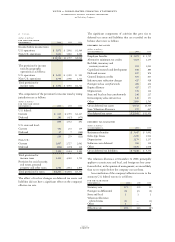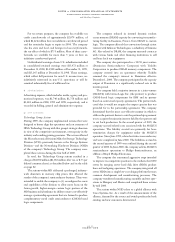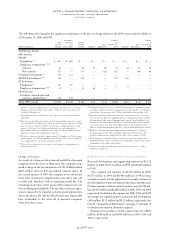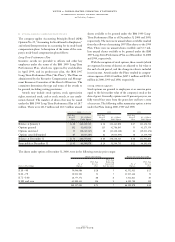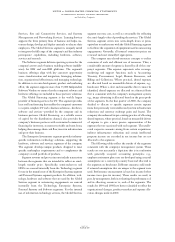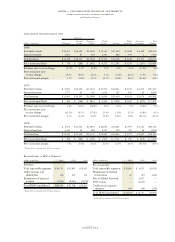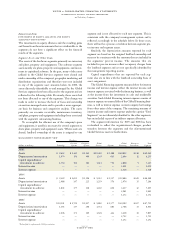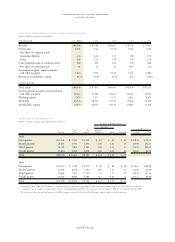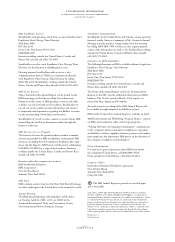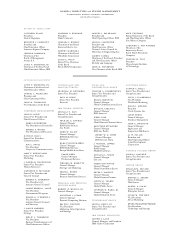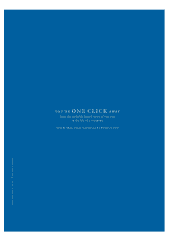IBM 2000 Annual Report Download - page 91
Download and view the complete annual report
Please find page 91 of the 2000 IBM annual report below. You can navigate through the pages in the report by either clicking on the pages listed below, or by using the keyword search tool below to find specific information within the annual report.
page no.
eighty-nine
notes to consolidated financial statements
international business machines corporation
and Subsidiary Companies
The benefit obligation was determined by applying the
terms of medical, dental and life insurance plans, including
the effects of established maximums on covered costs,
together with relevant actuarial assumptions. These actuar-
ial assumptions include a projected health care cost trend
rate of 6 percent.
WEIGHTED-AVERAGE
ACTUARIAL ASSUMPTIONS
AS OF DECEMBER 31: 2000 1999 1998
Discount rate 7.25% 7.75% 6.5%
Expected return on
plan assets 5.0% 5.0% 5.0%
The company evaluates its actuarial assumptions on an
annual basis and considers changes in these long-term factors
based upon market conditions and the requirements of SFAS
No. 106, “Employers’ Accounting for Postretirement
Benefits Other Than Pensions.” The discount rate changes
did not have a material effect on net postretirement benefit
cost for the years ended December 31, 2000, 1999 and 1998.
A one-percentage-point change in the assumed health
care cost trend rate would have the following effects as of
December 31, 2000:
One-Percentage- One-Percentage-
(dollars in millions) Point Increase Point Decrease
Effect on total service and
interest cost $«««8 $«(10)
Effect on postretirement
benefit obligation $«52 $«(65)
XSEGMENT INFORMATION
IBM uses advanced information technology to provide cus-
tomer solutions. The company operates primarily in a single
industry using several segments that create value by offering
a variety of solutions that include, either singularly or in
some combination, technologies, systems, products, services,
software and financing.
Organizationally, the company’s major operations comprise
three hardware product segments
—
Technology, Personal
Systems and Enterprise Systems; a Global Services segment; a
Software segment; a Global Financing segment and an Enter-
prise Investments segment. The segments are determined
based on several factors, including customer base, homo-
geneity of products, technology and delivery channels.
The Technology segment produces peripheral equipment
for use in general-purpose computer systems, including
storage devices, networking components, advanced function
printers and display devices. In addition, the segment provides
components such as semiconductors and HDDs for use in
the company’s products and for sale to original equipment
manufacturers (OEM). Major business units include Micro-
electronics, Storage Technology and Printing Systems.
The Personal Systems segment produces general-purpose
computer systems, including some system and consumer
software that operate applications for use by one user at a
time (personal computer clients) or as servers. Major brands
include the Aptiva home personal computers, IntelliStation
workstations, IBM xSeries servers, NetVista and ThinkPad
mobile systems. Also, in the first quarter of 2000, the com-
pany transferred the Retail Store Solutions (RSS) business, a
leader in providing point-of-sale solutions, to the Personal
Systems segment from the Enterprise Investments segment.
In the first quarter of 2000, the company reorganized the
Server segment and renamed it the Enterprise Systems
segment. In accordance with the organizational change, the
company transferred system-level product businesses from
the Technology segment to the Enterprise Systems segment.
The system-level product businesses are the company’s disk
storage products, which include the Enterprise Storage
Server known as “Shark,” tape subsystems and the company’s
storage area networking program, and networking products.
The segment also produces powerful multi-purpose computer
servers that operate many open-network-based applications
simultaneously for multiple users. They perform high-volume
transaction processing and serve data to personal systems
and other end-user devices. The servers are the engines
behind the bulk of electronic business transactions, including
e-commerce. Brands include the zSeries mainframe servers,
the heart of the e-business infrastructure for mission-critical
data and transaction processing, the IBM pSeries servers, the
most powerful technologically advanced UNIX servers, and
the IBM iSeries mid-range servers, integrated mid-range
business servers that run sophisticated business applications.
The Global Services segment is the world’s largest infor-
mation technology (I/T) services provider, supporting
computer hardware and software products and providing
professional services to help customers of all sizes realize the
full value of information technology. The segment provides
value through three primary lines of business: Strategic
Outsourcing Services, Business Innovation Services and
Integrated Technology Services. Strategic Outsourcing
Services creates business value through long-term strategic
partnerships with customers by taking on responsibility for
their processes and systems. Business Innovation Services
provides business/industry consulting and end-to-end
e-business implementation of such offerings as Supply
Chain Management, Customer Relationship Management,
Enterprise Resource Planning and Business Intelligence.
Integrated Technology Services offers customers a single
I/T partner to manage multi-vendor I/T systems’ com-
plexity in today’s e-business environment including such
traditional offerings as Product Support, Business Recovery



